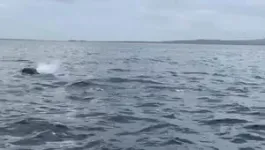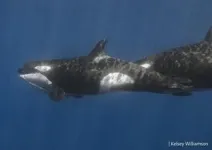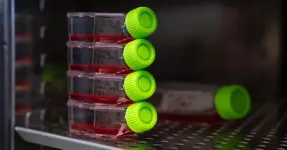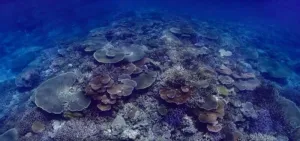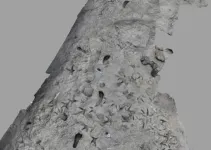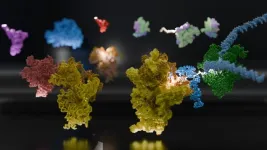(Press-News.org) Killer whales can feed on marine mammals, turtles, and fish. In the Gulf of California, a pod might have picked up new skills that help them hunt whale sharks – the world’s largest fish, growing up to 18 meters long.
Whale sharks feed at aggregation sites in the Gulf of California, sometimes while they are still young and smaller. During this life-stage, they are more vulnerable to predation, and anecdotal evidence suggests orcas could be hunting them. Now, researchers in Mexico have reported four separate hunting events.
“We show how orcas displayed a collaboratively hunting technique on whale sharks, characterized by focusing on attacking the pelvic area causing the whale shark to bleed out and allow orcas access to the lipid-rich liver,” said Erick Higuera Rivas, a marine biologist at Conexiones Terramar and senior author of the Frontiers in Marine Science article. “One individual was engaged in three of the four events, alongside with other members who might belong to a pod specialized on hunting on sharks.”
Specialized hunters
The predation events occurred between 2018 and 2024 in the southern Gulf of California and were captured in images and videos taken by members of the public and scientists. Individual orcas were identified by analyzing photographs of dorsal fins and distinctive features like scars.
In three of four hunting events a male orca called Moctezuma was present. A female orca previously observed in the presence of Moctezuma participated in one event also, suggesting they could be related or members of the same pod.
“When hunting, all pod members work together, hitting the whale shark to turn it upside down. In that position the sharks enter a state of tonic immobility and can no longer move voluntarily or escape by going deeper,” Higuera Rivas explained. “By keeping it under control, the orcas then have greater ease and speed in approaching the pelvic area of the shark and are able to extract organs of nutritional importance for them.”
Orcas may be targeting whale sharks’ ventral side because there their bodies are thought to be the least protected. For example, there is less muscle and cartilage in this area, allowing easier access to the aorta. Although whale sharks’ livers are an important part of orcas’ diets, there was no photographic observation of the orcas consuming the organ.
Hunting this way could imply that some orcas in the Gulf of California have acquired special skills that help them prey on whale sharks. In other regions, orcas may have learned to do the same thing, but evidence is limited, the researchers said.
Understanding how orcas hunt
Collecting the data the scientists needed wasn’t easy. Attacks cannot be predicted, access to images and videos can be limited, and image quality is oftentimes too low to reliably identify animals.
Despite this, the researchers said their finding could have several implications. The fact that there is a whale shark hunting pod in the Gulf of California increases the need for managing marine adventurers and tourists, the researchers cautioned. “There must be a specific regulatory norm that guarantees that any type of non-extractive use activity is carried out in a respectful and sustainable manner,” Higuera Rivas said.
Further, if the thesis that Moctezuma and his pod have acquired ecological and behavioral information for hunting whale sharks in the Gulf of California holds, the pod could be vulnerable to a possible disappearance of this specific prey due to climate change within the region.
Ultimately, new information related to these orcas helps researchers gain a greater understanding of their adaptations unique to their needs and geographical location. “It is very impressive how orcas work together strategically and intelligently to access only a very specific area of the prey. It highlights what great predators they are,” concluded Higuera Rivas.
END
Unique killer whale pod may have acquired special skills to hunt the world’s largest fish
Killer whales, including a male dubbed Moctezuma, have been spotted hunting whale sharks in coordinated attacks. Researchers think they may have gained special knowledge allowing them to hunt this way
2024-11-29
ELSE PRESS RELEASES FROM THIS DATE:
Emory-led Lancet review highlights racial disparities in sudden cardiac arrest and death among athletes
2024-11-29
UNDER STRICT EMBARGO UNTIL 6:30 PM November 28, 2024:
A recent major review of data published by the Lancet and led by Emory sports cardiologist Jonathan Kim, MD, shows that Black athletes are approximately five times more likely to experience sudden cardiac arrest (SCA) and sudden cardiac death (SCD) compared to White athletes, despite some evidence of a decline in rates of SCD overall. SCA and SCD have historically been a leading cause of mortality among athletes, particularly those involved in high-intensity sports.
The disparities in SCA/D rates highlights the need for increased research into the social determinants of health in younger athletes, a topic that remains ...
A new approach to predicting malaria drug resistance
2024-11-28
Researchers at University of California San Diego analyzed the genomes of hundreds of malaria parasites to determine which genetic variants are most likely to confer drug resistance. The findings, published in Science, could help scientists use machine learning to predict antimalarial drug resistance and more effectively prioritize the most promising experimental treatments for further development. The approach could also help predict treatment resistance in other infectious diseases, and even cancer.
“A lot of drug resistance research can only look at one chemical agent at a time, but what we’ve been able to do here is create a roadmap ...
Coral adaptation unlikely to keep pace with global warming
2024-11-28
Coral adaptation to ocean warming and marine heatwaves will likely be overwhelmed without rapid reductions of global greenhouse gas emissions, according to an international team of scientists.
Their study, led by Dr. Liam Lachs of Newcastle University, reveals that coral heat tolerance adaptation via natural selection could keep pace with ocean warming, but only if Paris Agreement commitments are realised, limiting global warming to two degrees Celsius.
“The reality is that marine heatwaves are triggering mass coral bleaching mortality events across the world’s shallow tropical reef ecosystems, and the increasing frequency and intensity of these events ...
Bioinspired droplet-based systems herald a new era in biocompatible devices
2024-11-28
UNDER EMBARGO UNTIL 19:00 GMT / 14:00 ET THURSDAY 28 NOVEMBER 2024
Bioinspired droplet-based systems herald a new era in biocompatible devices
Oxford University researchers have developed a set of biocompatible devices, which can replicate or surpass many electronic functions but use ions as the signal carriers.
The ‘dropletronic devices’ are made from miniature soft hydrogel droplets and can be combined to produce diodes, transistors, reconfigurable logic gates, and memory storage devices that mimic biological synapses.
The research team generated a biocompatible, dropletronic ...
A fossil first: Scientists find 1.5-million-year-old footprints of two different species of human ancestors at same spot
2024-11-28
More than a million years ago, on a hot savannah teeming with wildlife near the shore of what would someday become Lake Turkana in Kenya, two completely different species of hominins may have passed each other as they scavenged for food.
Scientists know this because they have examined 1.5-million-year-old fossils they unearthed and have concluded they represent the first example of two sets of hominin footprints made about the same time on an ancient lake shore. The discovery will provide more insight into human evolution and how species cooperated and competed with ...
The key to “climate smart” agriculture might be through its value chain
2024-11-28
In 2023, the United Nations climate conference (COP28) officially recognized the importance of agriculture in influencing and mitigating climate change. In a Policy Forum, Johan Swinnen and colleagues offer an approach to overcome challenges related to improving climate-sensitive farming practices across the globe. They discuss the importance of working with Agricultural Value Chains (AVC) by incentivizing small businesses who play an important role in the support of small- and medium-sized farms. This would involve both upstream enterprises related to seeds, fertilizer, ...
These hibernating squirrels could use a drink—but don’t feel the thirst
2024-11-28
The thirteen-lined ground squirrel doesn’t drink during its winter hibernation, even though systems throughout its body are crying out for water. Madeleine Junkins and colleagues now show that the squirrel suppresses the need to quench its thirst by reducing the activity of a set of neurons in highly vascularized brain structures called circumventricular organs, which act as a specialized connection point between brain, blood circulation and cerebrospinal fluid. The study by Junkins et al. helps explain how some hibernating animals ignore the powerful physiological drive to seek out water ...
New footprints offer evidence of co-existing hominid species 1.5 million years ago
2024-11-28
Newly discovered footprints show that at least two hominid species were walking through the muddy submerged edge of a lake in Kenya’s Turkana Basin at the same time, about 1.5 million years ago. The find from the famous hominid fossil site of Koobi Fora described by Kevin Hatala and colleagues provides physical evidence for the co-existence of multiple hominid lineages in the region—something that has only been inferred previously from overlapping dates for scattered fossils. Based on information on gait and stance gleaned from the footprints, Hatala et al. think that the two species were Homo erectus and Paranthropus ...
Moral outrage helps misinformation spread through social media
2024-11-28
Social media posts containing misinformation evoke more moral outrage than posts with trustworthy information, and that outrage facilitates the spread of misinformation, according to a new study by Killian McLoughlin and colleagues. The researchers also found that people are more likely to share outrage-evoking misinformation without reading it first. The findings suggest that attempts to mitigate the online spread of misinformation by encouraging people to check its accuracy before sharing may not be successful, the researchers ...
U-M, multinational team of scientists reveal structural link for initiation of protein synthesis in bacteria
2024-11-28
IMAGE
ANN ARBOR—Within a cell, DNA carries the genetic code for building proteins.
To build proteins, the cell makes a copy of DNA, called mRNA. Then, another molecule called a ribosome reads the mRNA, translating it into protein. But this step has been a visual mystery: scientists previously did not know how the ribosome attaches to and reads mRNA.
Now, a team of international scientists, including University of Michigan researchers, have used advanced microscopy to image how ribosomes recruit to mRNA while it's being transcribed by an enzyme called RNA polymerase, or RNAP. Their results, which examine the process in bacteria, are published in the journal ...
LAST 30 PRESS RELEASES:
Air pollution exposure and birth weight
Obstructive sleep apnea risk and mental health conditions among older adults
How talking slows eye movements behind the wheel
The Ceramic Society of Japan’s Oxoate Ceramics Research Association launches new international book project
Heart-brain connection: international study reveals the role of the vagus nerve in keeping the heart young
Researchers identify Rb1 as a predictive biomarker for a new therapeutic strategy in some breast cancers
Survey reveals ethical gaps slowing AI adoption in pediatric surgery
Stimulant ADHD medications work differently than thought
AI overestimates how smart people are, according to HSE economists
HSE researchers create genome-wide map of quadruplexes
Scientists boost cell "powerhouses" to burn more calories
Automatic label checking: The missing step in making reliable medical AI
Low daily alcohol intake linked to 50% heightened mouth cancer risk in India
American Meteorological Society announces Rick Spinrad as 2026 President-Elect
Biomass-based carbon capture spotlighted in newly released global climate webinar recording
Illuminating invisible nano pollutants: advanced bioimaging tracks the full journey of emerging nanoscale contaminants in living systems
How does age affect recovery from spinal cord injury?
Novel AI tool offers prognosis for patients with head and neck cancer
Fathers’ microplastic exposure tied to their children’s metabolic problems
Research validates laboratory model for studying high-grade serous ovarian cancer
SIR 2026 delivers transformative breakthroughs in minimally invasive medicine to improve patient care
Stem Cell Reports most downloaded papers of 2025 highlight the breadth and impact of stem cell research
Oxford-led study estimates NHS spends around 3% of its primary and secondary care budget on the health impacts of heat and cold in England
A researcher’s long quest leads to a smart composite breakthrough
Urban wild bees act as “microbial sensors” of city health.
New study finds where you live affects recovery after a hip fracture
Forecasting the impact of fully automated vehicle adoption on US road traffic injuries
Alcohol-related hospitalizations from 2016 to 2022
Semaglutide and hospitalizations in patients with obesity and established cardiovascular disease
Researchers ‘listen in’ to embryo-mother interactions during implantation using a culture system replicating the womb lining
[Press-News.org] Unique killer whale pod may have acquired special skills to hunt the world’s largest fishKiller whales, including a male dubbed Moctezuma, have been spotted hunting whale sharks in coordinated attacks. Researchers think they may have gained special knowledge allowing them to hunt this way

